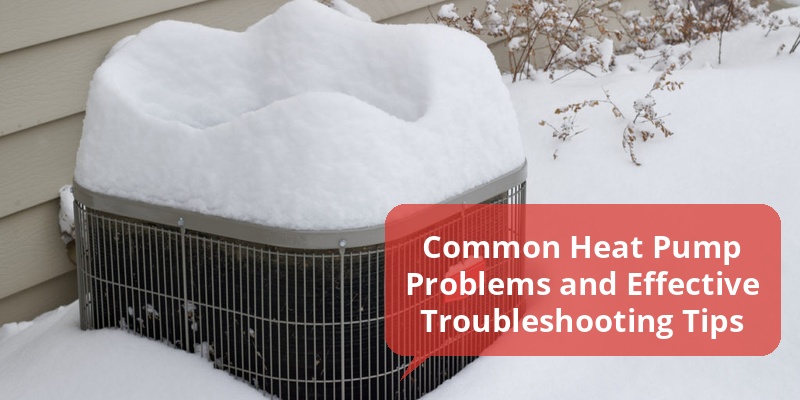Heat pumps are an energy-efficient solution for heating and cooling homes, yet like any HVAC system, they can encounter issues. Recognizing common heat pump problems early can prevent costly repairs and maintain home comfort. This article discusses the typical issues homeowners face with heat pumps, their causes, and practical troubleshooting steps to help diagnose and resolve these problems.
| Common Problem | Symptoms | Possible Causes | Basic Troubleshooting |
|---|---|---|---|
| Heat Pump Not Heating or Cooling | No air flow or insufficient temperature change | Dirty filters, refrigerant leak, thermostat issues | Clean filters, check thermostat, call technician for leaks |
| Frozen Outdoor Unit | Ice buildup on coils, reduced efficiency | Poor airflow, refrigerant low, defrost cycle failure | Clear debris, ensure airflow, clean coils, inspect defrost controls |
| Loud or Unusual Noises | Rattling, humming, squealing sounds | Loose parts, motor issues, fan problems | Tighten parts, lubricate motor, replace worn components |
| Heat Pump Keeps Turning On and Off | Frequent cycling causing discomfort | Improper size, thermostat location, short cycling | Check thermostat placement, inspect refrigerant levels, professional evaluation |
| High Energy Bills | Unexpected increase in utility costs | Poor maintenance, refrigerant leaks, inefficient operation | Regular maintenance, monitor energy use, repair leaks |
Heat Pump Fails to Heat or Cool Properly
One of the most common heat pump problems is when the system fails to provide adequate heating or cooling. This may result in inconsistent air temperature or no temperature change at all. The causes behind this issue are often related to airflow restrictions, thermostat malfunctions, or refrigerant problems.
Dirty air filters are a frequent culprit, obstructing airflow and making the system work harder without delivering comfort. Replacing or cleaning filters monthly during heavy use seasons can improve performance.
A malfunctioning thermostat can also cause incorrect temperature readings, leading the heat pump to stop operating prematurely or fail to turn on. Checking the thermostat settings, replacing batteries, or recalibrating can resolve such issues.
Refrigerant leaks or low refrigerant levels impact the heat pump’s ability to transfer heat efficiently. This requires professional inspection and repair since refrigerant handling involves strict regulations.
Outdoor Unit Freezing Issues
Outdoor units can develop ice buildup on the coils, causing the heat pump to underperform. This problem occurs mainly during colder months when excessive ice formation interferes with heat exchange.
Ice accumulation can result from inadequate airflow due to dirty coils, blocked vents, or malfunctioning fans. Cleaning debris and ensuring the unit is clear of obstructions help maintain proper airflow.
Failure in the defrost cycle, which melts ice periodically, might cause persistent freezing. Additionally, a low refrigerant charge can contribute to coil icing. Regular inspections and maintenance can prevent freeze-ups and protect system components.
Unusual Noises Indicating Mechanical Issues
Heat pumps typically operate quietly, so strange noises such as rattling, squealing, or humming often indicate underlying mechanical problems.
Rattling sounds may be caused by loose components or debris caught in the outdoor unit. Regular inspection and tightening of screws and bolts can reduce noise.
Squealing noises often stem from worn belts or motor bearings needing lubrication or replacement. Humming can signal electrical issues or compressor problems requiring professional evaluation.
Frequent Cycling of Heat Pump
If the heat pump frequently turns on and off, a condition known as short cycling, it can reduce equipment lifespan and increase energy costs.
Short cycling typically occurs when the system is oversized for the space, causing it to reach temperature setpoints too quickly and shut off repeatedly.
Improper thermostat placement, such as near heat sources or drafts, can call for rapid cycling as well. Ensuring correct placement and professional sizing evaluation is critical.
Refrigeration problems and dirty coils can also contribute to short cycling by disrupting normal heat exchange.
Rising Energy Bills Due to Declining Efficiency
Heat pumps are designed for efficiency, but poor maintenance or malfunctions can lead to elevated energy consumption and higher utility bills.
Common causes include clogged filters, refrigerant leaks, faulty components, and failing defrost cycles. Routine maintenance helps sustain efficiency and detect issues before they escalate.
Investing in periodic professional inspections and timely repairs saves money over time and maintains system reliability.
Essential Regular Maintenance Tips for Heat Pumps
- Clean or replace air filters every 1-3 months depending on usage and air quality.
- Ensure outdoor units are free of leaves, dirt, and debris.
- Regularly inspect and clean coil fins to maintain airflow.
- Verify thermostat settings and check battery health yearly.
- Schedule annual professional inspections to check refrigerant levels, electrical components, and system calibration.
- Monitor unusual noises or system behavior promptly.
When to Call a Professional Technician
While many heat pump issues can be prevented with routine maintenance, some problems require expert attention. Refrigerant leaks, compressor failures, electrical malfunctions, and complex defrost system repairs should be handled by qualified HVAC professionals.
Attempting DIY repairs on sensitive components can void warranties or cause further damage, emphasizing the importance of professional service.
Timely intervention also extends the heat pump’s lifespan and ensures optimal energy efficiency and comfort for homeowners.
